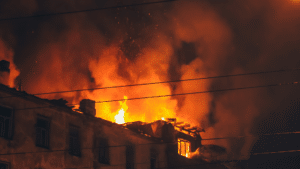
In the realm of commercial property management, understanding the various types of fires and their consequent health implications is crucial. Structural fires in buildings typically fall into three categories—synthetic, protein, and natural fires—each with distinct characteristics and remediation processes. This knowledge not only aids in effective risk assessment and emergency planning but also plays a vital role in post-fire recovery and mitigation efforts.
The Trio of Fire Types
- Synthetic Fires: These fires are commonly fueled by plastics and synthetic materials which, when burned, produce a dense black smoke known for its propensity to smear upon contact. The synthetic nature of these materials means the fire can be extremely charged, leading to the formation of smoke webs—a complex cleanup challenge that requires specialised attention.
- Protein Fires: Often a result of cooking processes that have gone awry, protein fires typically involve animal fats and meats. The residue left behind from these fires is a greasy soot that can be yellowish or tan, indicating incomplete combustion. It’s localised but can be stubborn to clean, emphasising the need for immediate action to prevent the spread to other areas.
- Natural Fires: Originating from paper products, natural textiles, and cellulose materials, natural fires leave a powdery residue typically easier to clean than its synthetic or protein counterparts. However, they are characterised by a distinct natural odour that requires thorough ventilation and air purification to eliminate.
Health Implications of Fire Residues
The health implications of fire types for occupants and cleanup crews cannot be overstated. Smoke from synthetic materials contains a cocktail of chemicals that can be extremely toxic and harmful if inhaled. Even smoke from seemingly ‘natural’ sources like wood can be just as hazardous, underscoring the importance of using proper personal protective equipment (PPE) during the remediation process.
The toxicity warning is clear: avoid exposure to smoke at all costs and seek medical attention if affected. For property owners, this translates to an imperative need to have an action plan that includes immediate evacuation, timely professional assessment, and comprehensive cleanup procedures.
Mitigating Health Risks: A Proactive Approach
As a commercial property owner, your primary concern post-fire should be the health and safety of your tenants and employees. Here are action steps to mitigate risks:
- Conduct Regular Fire Risk Assessments: Regularly review and update fire risk assessments for your property. This should include identifying potential sources of synthetic, protein, and natural fires and devising strategies to reduce these risks.
- Educate Tenants and Staff: Inform tenants and staff about the different types of fires and the specific health risks associated with each. Educate them on emergency procedures, the importance of immediate evacuation, and the health implications of smoke inhalation.
- Invest in Quality Fire Safety Equipment: Ensure your property is equipped with high-grade fire extinguishers, smoke detectors, and fire suppression systems that are appropriate for the different types of fires that could occur.
- Professional Cleanup Services: Partner with a professional fire remediation service that specialises in dealing with the aftermath of all fire types. This ensures that the health risks from fire residues are properly addressed and that your property is restored to a safe and healthy condition.
- Regular Health Screenings: After a fire incident, offer health screenings for those exposed to fire residues. This proactive approach not only demonstrates your commitment to their well-being but also helps to detect and address any health issues early on.
Conclusion: A Call to Action
As a commercial property owner, the safety of your tenants and the integrity of your property hinge on your preparedness and response to fire incidents. Recognizing the types of fires and their associated health risks is just the starting point. Taking proactive steps to mitigate these risks and ensuring the well-being of all building occupants is your ultimate responsibility.
Engage with professional services, stay informed, and prioritise health and safety in all fire-related matters. By doing so, you’ll not only protect your property investment but also demonstrate a high level of care and due diligence that is sure to be valued by all who occupy your premises.
Be vigilant, be prepared, and be the exemplar of safety in the commercial property landscape.
